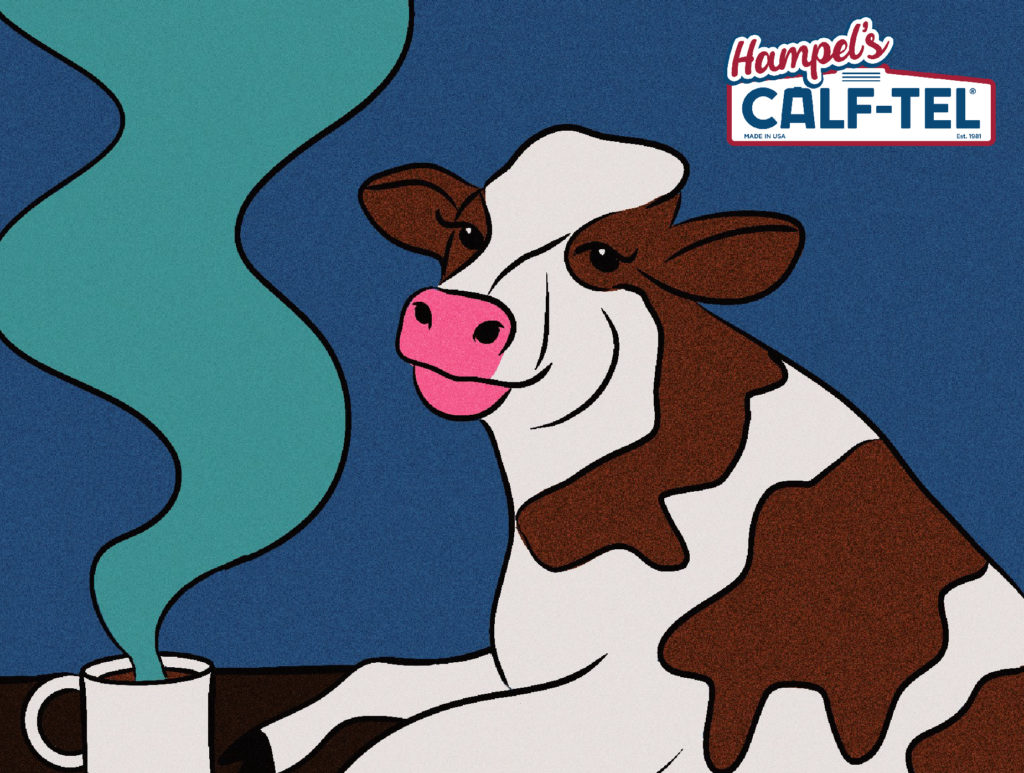By Cari Reynolds, W. H. Miner Agricultural Research Institute

One thing that I will never tire of is watching all the different ways that calves drink from a pail. Some cleanly and efficiently finish their offering in a matter of seconds, some sink their heads up to their eyeballs longer than a Navy diver on a recovery mission, and some slurp loudly enough to be heard at the other end of the barn. Our calf manager observed recently that one of our calves daintily sips at her milk, as though she’s having tea. Lady Sippinsby, as my overactive imagination immediately coined her, would likely be very excited to know that research examining possible benefits of green tea extract to newborn calves has recently been published in the Journal of Dairy Science. Could a spot of tea provide benefits to calves born by dystocia?
Calves experiencing dystocia, or difficult birth, can often experience poor vigor. Indicators of poor vigor can include delayed suckling reflex, slower standing time, and failure of passive transfer due to inadequate colostrum ingestion, all of which can have long-term consequences on calf performance. Absorption of immunoglobulin G (IgG) from colostrum can also be affected by poor vigor. Nonsteroidal anti-inflammatory drugs (NSAID) have been administered to calves to alleviate effects of dystocia, but some results suggest that they may also interfere with IgG absorption. Since parturition is an inflammatory process for the calf, the anti-inflammatory properties of green tea extract may improve stimulation and early life vitality as an alternative to NSAID. The antioxidants, flavonoids, and polyphenols of green tea extract- all exhibiting antimicrobial and anti-inflammatory benefits- have demonstrated health effects in preweaning calves, but no studies have evaluated effects of administration immediately after birth. Researchers at the University of Kentucky were interested in determining if green tea extract had any association with apparent efficiency of absorption (AEA) and would improve vigor if administered after birth. It was hypothesized that green tea supplementation would not affect AEA, and that vigor would be improved within 72 h after birth.
The 24 calves enrolled in the study (10 heifers and 14 bulls) were randomized to receive either a 15 mL dose of green tea extract or a control of distilled water, which was administered 3 h after birth. Three liters of colostrum replacer with 150 g of IgG was tube-fed 4 h after birth. Blood samples were collected from the calves at 2.5 h after birth, and again at 6, 12, 24, 48, and 72 h after birth. Vigor assessments, such as heart rate, respiration rate, initial movement, rectal temperature, and response to stimulation (a piece of straw in the nasal cavity) were performed on the calves before removal from the dam, after placement in an individual pen, after green tea supplementation, and at 6, 12, 24, 48, and 72 h after birth. Vigor was scored on a scale of 0-3 (0= poor vigor, 1= reduced vigor, 2= normal vigor, 3= alert).
Nineteen of the 24 calves enrolled in the study experienced normal births. Mean serum IgG concentrations for the green tea and control groups were 13.56 ± 0.80 and 12.38 ± 0.80 g/L, respectively, with AEA for both groups at 24 h averaging 25.73 ± 1.17%. Average AEA in healthy calves is typically between 20-35%, so while there were not enough calves born by dystocia to evaluate a true effect, these results support the hypothesis that the green tea supplementation did not affect AEA. However, no evidence of difference in overall vigor scores was observed, and all but five calves demonstrated either normal or alert vigor scores at 72 h after birth. The authors also suggested that the 15 mL dose of green tea extract may not have been enough, so a higher dosage may be a consideration for future study. These results invite further exploration of green tea extract on the health and vitality of newborn calves, and future work should include more calves born under stressful conditions to determine if green tea extract provides any therapeutic effect.
Standing, walking, exploring the pen environment, and vigilance behavior (ears forward toward pen entrance) within the first 24 h after birth are some easily-observed examples of vitality in newborn calves. Calves that have experienced a difficult birth should be monitored for any signs of poor vigor, and intervention provided if the calf is struggling to breathe, cannot stand, or appears to be in pain. As always, provide high-quality colostrum (Brix >22% or >50 g/L) within 2 h of birth to facilitate adequate absorption of IgG. Calves who demonstrate poor suckling reflex should be tube-fed to ensure that the whole allotment is received. Pens should be dry and clean to reduce exposure to enteric pathogens such as E. coli, and calves should be dry and kept warm with a bed of straw or dry sawdust. Toweling off the calf after removal from the dam also be an encouraging stimulant.
With the opportunity to further explore the use of green tea extract in newborn calves, perhaps improving vitality could be added to the list of life’s tribulations that are able to be solved with a cup of tea.
Cari Reynolds can be reached at reynolds@whminer.com with questions or comments.
References
Godden, S.M., J.E. Lombard, and A.R. Woolums. 2019. Colostrum management for dairy calves. Vet Clin North Am Food Anim Prac. 35(3):535-556. DOI: 10.1016/j.cvfa.2019.07.005
Quigley, J.D., C.J. Kost, and T. M. Wolfe. 2002. Absorption of Protein and IgG in Calves Fed a Colostrum Supplement or Replacer. J. Dairy Sci. 85(5): 1243-1248.
Reis, M.E., M. Cantor, C. M.M. Bittar, and J.H.C. Costa. 2022. Association of a green tea extract with serum immunoglobulin G status and neonatal vitality in newborn calves. J. Dairy Sci. 105:2022- 2029. DOI: https://doi.org/10.3168/jds.2022-22099
